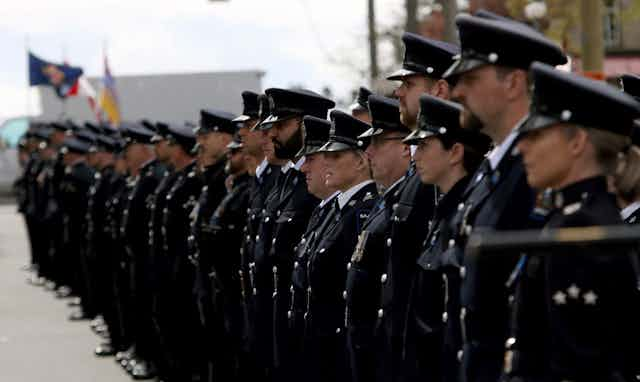After an alleged targeted campaign of bullying and sexual harassment by fellow members of the Vancouver Police Department, Const. Nicole Chan died by suicide in January 2019.
A coroner’s inquest is now underway, examining the circumstances leading to her senseless, preventable death — despite the fact that key witnesses, including the officers at the centre of the British Columbia Police Act investigation, aren’t on the witness list.
Police violence and misconduct are once again in the global spotlight after unarmed Black man Tyre Nichols died following a severe police beating in Memphis, Tenn.

Read more: Pain of police killings ripples outward to traumatize Black people and communities across US
A pervasive history of bullying and sexual misconduct plagues law enforcement agencies and illustrates the failure of police forces to police themselves. Perhaps this culture might also explain the acts of violence police officers perpetrate on civilians.
In Canada, sexual harassment lawsuits involving the RCMP and targeted bullying, discrimination and sexualized violence in many police departments demonstrate how law enforcement leadership is unable to keep its members safe from one another.
Workplace bullying on the rise
At any given time, 20 to 30 per cent of workers in North America have experienced workplace bullying, and that number soars to 60 per cent for first responders.
According to multiple studies, 80 per cent of women and 30 per cent of men have experienced sexual harassment in the workplace. In nearly three-quarters of all cases, the perpetrators hold positions of power.
The impact on those subjected to the abuse includes severe psychological harm, such as anxiety, depression, post-traumatic stress disorder and suicide.
The impenetrable ‘blue wall’
Similar to the insular nature of the Canadian Armed Forces, also confronting a culture of bullying and sexualized violence within its ranks, the phenomenon of “cop culture” is equally problematic.
Read more: Misogyny in police forces: understanding and fixing 'cop culture'
The shared set of beliefs, traditions and values in police forces often create a strong sense of cohesion, loyalty and camaraderie among its members.
However, cop culture has been widely criticized for creating an “us versus them” mentality among police officers, resulting in a lack of transparency and accountability surrounding their actions.
A pervasive code of silence exists in cop culture where targets are discouraged from reporting misconduct. Those who do are often shamed, isolated, gaslit and branded “rats.”
This is a failure of leadership — at all levels.

Human resources can’t get it right
Addressing the culture of workplace bullying and sexual harassment falls squarely on the shoulders of human resources departments and organizational leadership, including oversight boards. Unfortunately, the mismanagement of these issues are commonplace and have adverse outcomes.
Many organizations are ill-equipped and unwilling to address these type of issues. Many also lack HR professionals trained in these types of investigations. But this is no longer an acceptable excuse.
Despite zero-tolerance policies when it comes to bullying and sexual harassment, in practice, they don’t typically work in favour of those being targeted and are often unenforced — especially when the perpetrator is a boss.
There are federal and provincial occupational health and safety legislation to address workplace bullying and sexual harassment. But despite the prevalence and adverse impact on employees being targeted, these laws don’t sufficiently support the complainant, are difficult to navigate, are often misinterpreted and remain relatively toothless.
In fact, the Office of the Police Complaint Commissioner decided against holding an inquiry into Chan’s case because it was deemed “not in the best interest of the public” — when in reality, the systemic issues of sexual harassment and bullying on police forces is the very definition of the public interest.
Chan filed a WorkSafeBC complaint against the Vancouver Police Department, but it appeared to focus on process rather than on her safety.

But she did everything right.
She went to her supervisors for help — they allegedly failed to provide assistance. She complained to HR and the situation worsened. When in crisis, she was taken to hospital by police under the Mental Health Act and despite this was discharged two hours before she took her own life.
At every turn, the system failed her. Why? Because when the bully is the boss, the power imbalance is severe. And when organizations just pay lip service to keeping employees protected from bullying and sexual harassment, people get hurt.
What now?
Most police officers and administrators who choose to serve our communities are honourable people.
Problems occur when those in positions of authority abuse their status, exploit their power, violate law and policy and turn a blind eye to misconduct.
Chan’s story is a classic example of how the system, oversight bodies, the Vancouver Police Department, the Office of the Police Complaint Commissioner, the City of Vancouver, WorkSafeBC, Vancouver General Hospital and her colleagues in blue failed her at every turn.
At this moment, countless others are living similar stories — yet nothing is done, and those in leadership positions offer up very little by way of explanation.
In Canada, immediate changes to provincial police acts are required to include charges for any officers who witness or are aware of bullying or sexual harassment and fail to report. Canada’s Criminal Code also requires amendments that would make workplace violence, bullying and sexual harassment criminal offences.
In British Columbia, creating new powers for the Office of the Police Complaint Commissioner to independently investigate and address complaints of bullying and sexual harassment outside the department chain of command is a logical next step.
Thinking bigger, perhaps it’s time to create provincial workplace conduct commissioners who have the power and authority to intervene on issues of bullying and sexual harassment.
Chan’s death is a stark reminder that workplace bullying and sexual harassment is deadly. Society and her employer failed her.
And until police forces deal with the multitude of systemic issues that encourage and cover up workplace violence, it’s difficult not to wonder who’s next.

